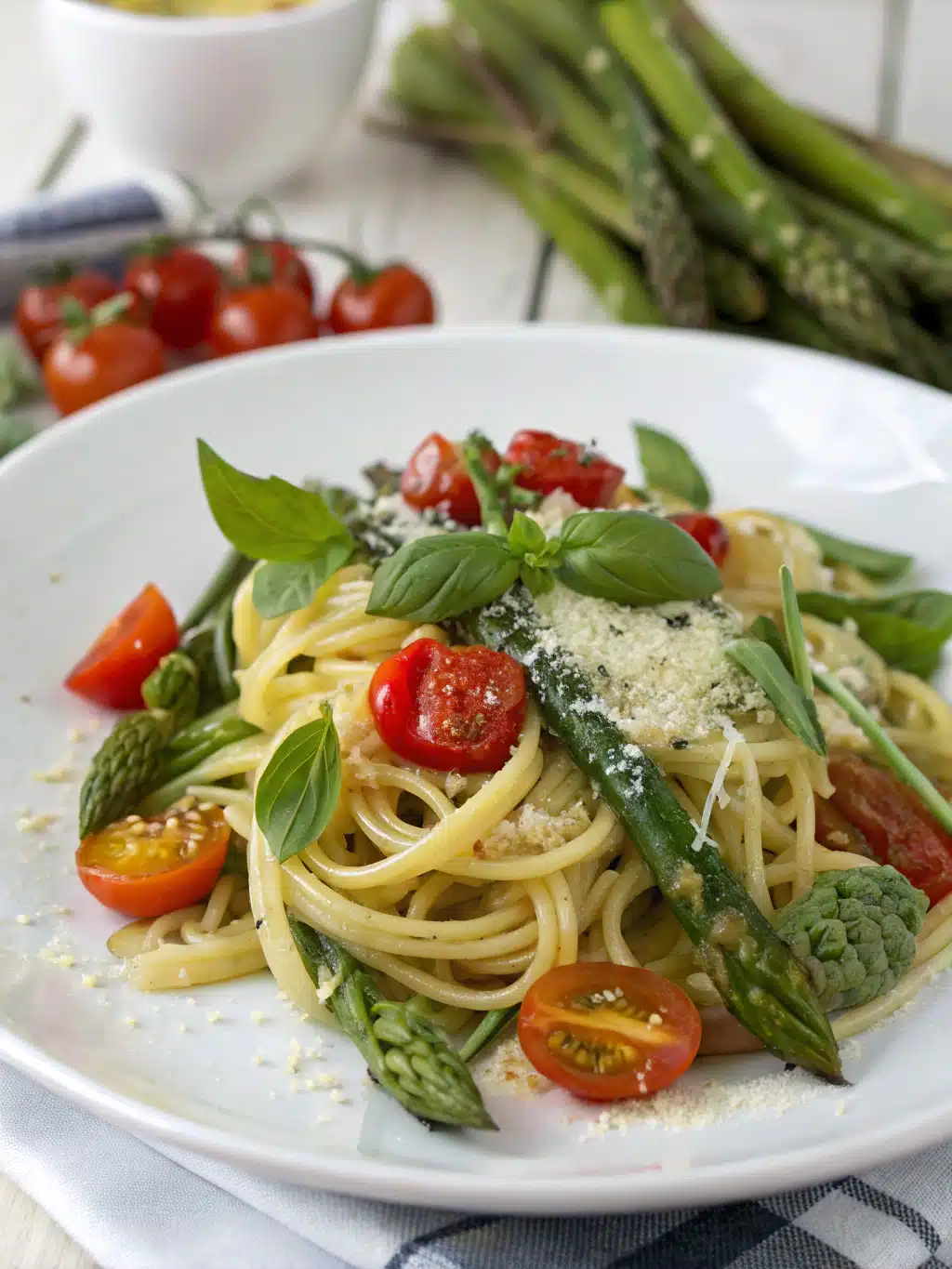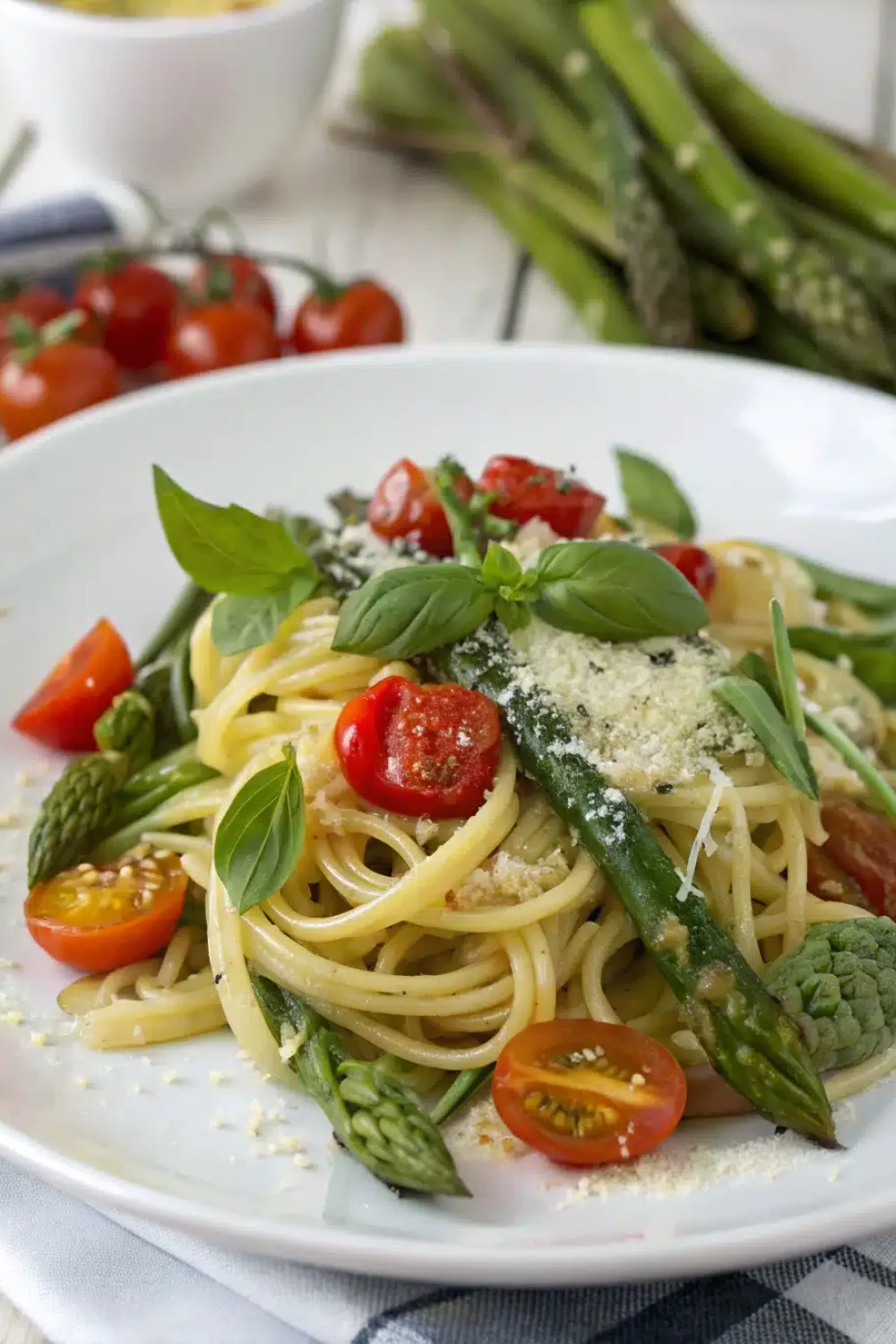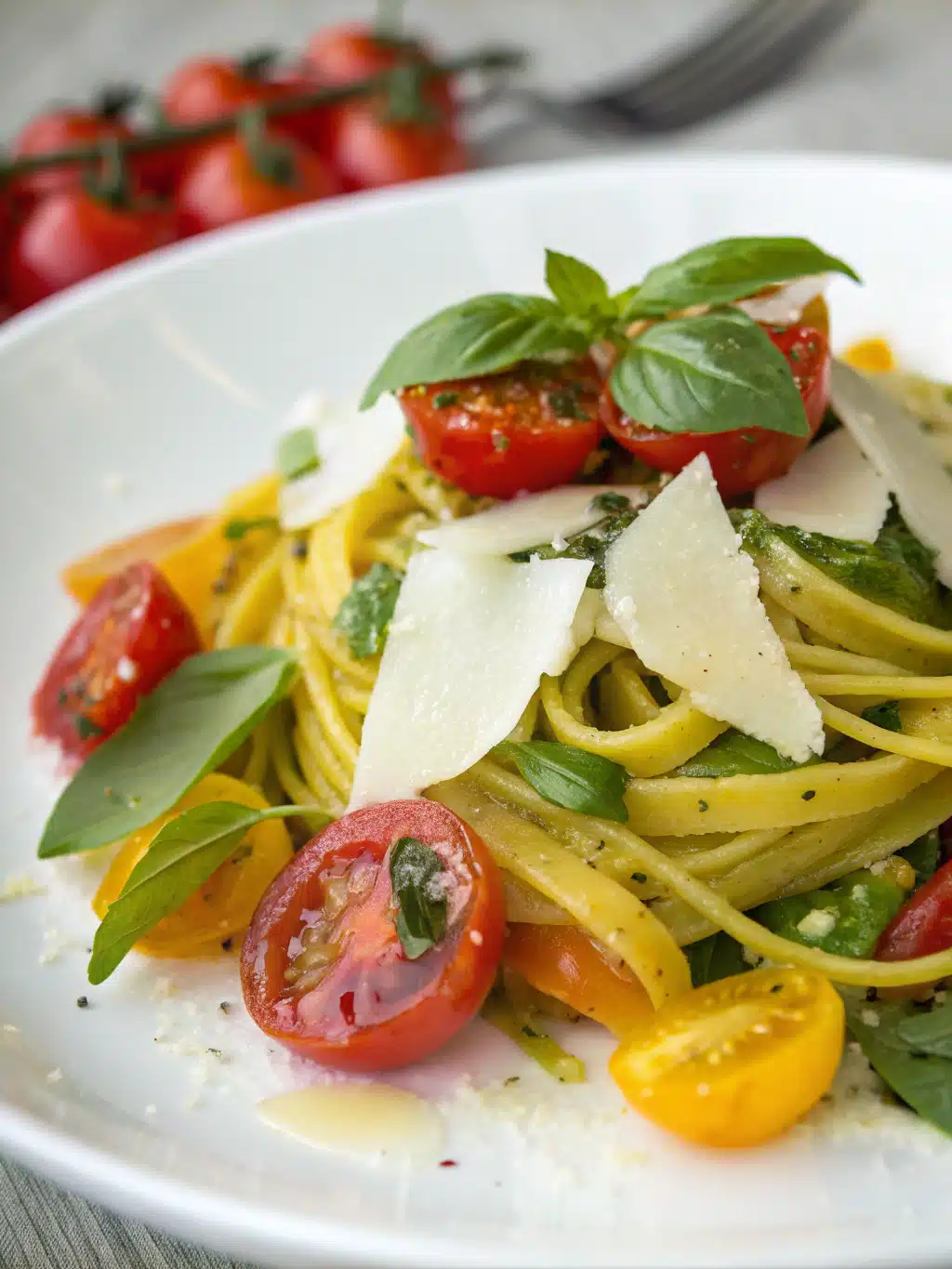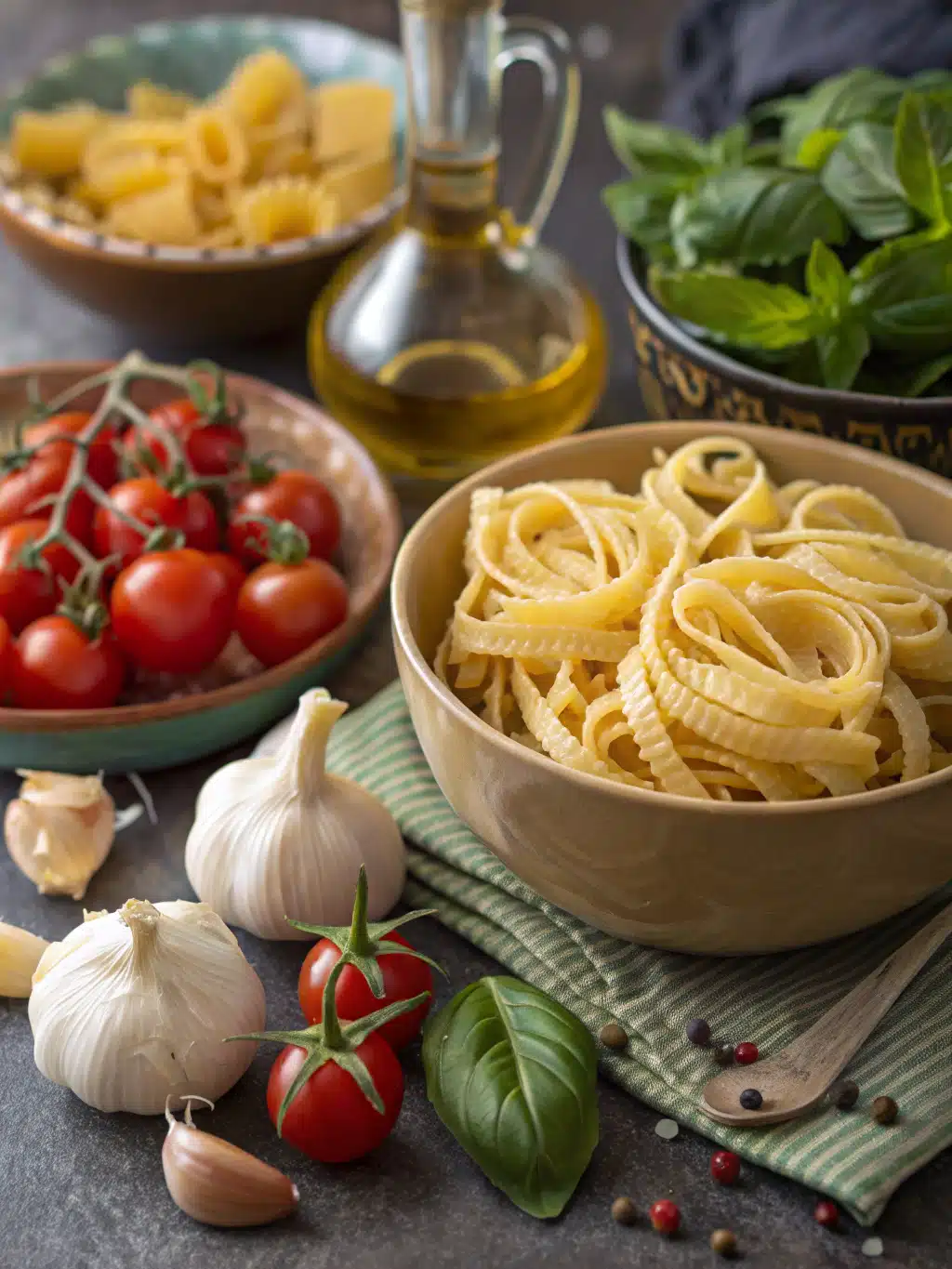Want to save this recipe?
Enter your email below and we’ll send the recipe straight to your inbox!
Introduction
Did you know that seasonal eating can increase your nutrient intake by up to 30% compared to consuming out-of-season produce? As the snow melts and farmers’ markets bloom with vibrant colors, it’s the perfect time to celebrate spring with this light and veggie-packed Spring Pasta. This dish captures the essence of the season – bright, refreshing, and bursting with the flavors of tender spring vegetables. Whether you’re a seasoned chef or exploring fresh pasta recipes for the first time, this versatile dish offers something for everyone, combining simplicity with spectacular seasonal flavors that will transform your weeknight dinner routine.
Ingredients List
For the pasta and vegetables:
- 12 oz fettuccine (substitute with spaghetti or linguine)
- 1 bunch asparagus, woody ends removed, cut into 2-inch pieces
- 1 cup fresh peas (frozen works too)
- 1 cup cherry tomatoes, halved
- 2 medium zucchini, spiralized or thinly sliced
- 2 cups baby spinach
- 3 cloves garlic, minced
For the sauce:
- 3 tablespoons extra virgin olive oil
- 1 tablespoon unsalted butter
- Zest and juice of 1 lemon
- ½ cup freshly grated Parmesan cheese (substitute with nutritional yeast for vegan option)
- ¼ cup fresh basil, chopped
- 2 tablespoons fresh mint, chopped
- Salt and freshly ground black pepper to taste
- Pinch of red pepper flakes (optional)
Timing
- Preparation: 15 minutes
- Cooking: 20 minutes
- Total Time: 35 minutes (approximately 40% faster than traditional pasta dishes that require slow-simmering sauces)
Step-by-Step Instructions
Step 1: Prepare Your Vegetables
Begin by washing all vegetables thoroughly. Trim the woody ends from your asparagus (approximately the bottom third), then slice into 2-inch pieces. Halve the cherry tomatoes, mince the garlic, and prepare any other vegetables. Pro tip: Create an ice bath for blanching your asparagus and peas to preserve their vibrant green color and crisp texture.
Step 2: Cook the Pasta
Bring a large pot of generously salted water to a rolling boil. The water should taste like the sea – this is the only opportunity to season the pasta itself! Add the pasta and cook until al dente, usually 1-2 minutes less than package instructions suggest. For authentic Spring Pasta, the noodles should retain a slight bite.
Step 3: Blanch the Spring Vegetables
While the pasta cooks, blanch the asparagus and fresh peas in the same pot for the last 2 minutes of cooking time. If using frozen peas, add them in the final minute. This technique saves time and dishes while ensuring perfectly cooked vegetables.
Step 4: Prepare the Sauce Base
In a large skillet over medium heat, warm the olive oil and butter. Add minced garlic and sauté until fragrant but not browned, about 30 seconds. Add the red pepper flakes if using. This aromatic base will infuse the entire dish with flavor.
Step 5: Bring It All Together
Using tongs, transfer the cooked pasta and blanched vegetables directly into the skillet, bringing along some of the starchy pasta water. Add the zucchini, cherry tomatoes, and spinach. Toss everything together and let cook for 1-2 minutes until the spinach wilts and tomatoes slightly soften.
Step 6: Finish with Fresh Flavors
Remove the skillet from heat. Add lemon zest, lemon juice, fresh herbs, and Parmesan cheese. Toss everything together, adding a splash of reserved pasta water if needed to create a light, silky sauce that coats every strand. Season with salt and pepper to taste.
Nutritional Information
Per serving (serves 4):
- Calories: 420
- Protein: 15g
- Carbohydrates: 58g
- Fat: 16g (mostly healthy unsaturated fats)
- Fiber: 8g (27% of daily recommended intake)
- Vitamin C: 45% of daily recommended value
- Vitamin A: 38% of daily recommended value
- Iron: 15% of daily recommended value
Healthier Alternatives for the Recipe
Transform this already nutritious dish with these wellness-focused swaps:
- Replace traditional pasta with whole grain, chickpea, or zucchini noodles to increase fiber and reduce carbohydrates by up to 40%
- Substitute half the oil with vegetable broth for a lighter sauce that maintains flavor while reducing fat content
- Add white beans or grilled chicken for additional protein without compromising the dish’s spring essence
- For dairy-free diners, replace Parmesan with nutritional yeast and use olive oil instead of butter
Serving Suggestions
Elevate your fresh pasta recipes with these complementary pairings:
- Serve with a chilled glass of Sauvignon Blanc or Pinot Grigio to highlight the dish’s herbaceous notes
- Accompany with a simple arugula salad dressed in lemon vinaigrette for a complete spring meal
- Finish with a slice of lemon sorbet or fresh berries to echo the meal’s seasonal lightness
- For an elegant presentation, serve in warmed bowls with extra herbs and Parmesan for tableside garnishing
Common Mistakes to Avoid
- Overcooking the pasta and vegetables: They should maintain their bite and vibrant color
- Under-seasoning the pasta water: Studies show properly salted water is crucial for pasta flavor development
- Using olive oil past its smoke point: This creates bitter notes that can overwhelm the delicate spring flavors
- Skipping the pasta water addition: This starchy liquid is essential for creating a silky, cohesive sauce
- Adding herbs too early: Fresh herbs lose their brightness when cooked too long
Storing Tips for the Recipe
- Store leftover pasta in an airtight container for up to 3 days in the refrigerator
- Refresh leftovers with a splash of water or vegetable broth when reheating
- For meal prep, blanch vegetables and store separately from cooked pasta to prevent sogginess
- Freeze individual portions for up to 1 month; thaw overnight in the refrigerator and reheat gently
- Make the sauce components ahead and store separately; combine freshly when ready to serve
Conclusion
This Spring Pasta isn’t just a meal—it’s a seasonal celebration that brings nature’s bounty directly to your table. With its perfect balance of fresh vegetables, bright citrus, and comforting pasta, this dish embodies the essence of spring cooking: simple ingredients transformed through thoughtful preparation. Whether you’re cooking for a special occasion or elevating your weeknight dinner rotation, this versatile recipe adapts to your needs while consistently delivering vibrant flavors and nourishment. What spring vegetables will you incorporate into your next pasta creation?
FAQs
Can I make this pasta dish vegan?
Absolutely! Simply omit the butter and Parmesan cheese, replacing them with additional olive oil and nutritional yeast or a vegan cheese alternative. The abundance of fresh vegetables ensures the dish remains flavorful and satisfying.
What’s the best pasta shape for this spring recipe?
While the recipe calls for fettuccine, any long pasta works beautifully. For maximum sauce absorption, consider shapes with ridges or hollows like orecchiette or fusilli, which capture the light sauce in their crevices.
Can I prepare any components of this dish ahead of time?
Yes! Blanch the vegetables and store them in the refrigerator for up to 24 hours. The herb and lemon mixture can also be prepared ahead. Cook the pasta fresh when you’re ready to assemble the final dish.
How can I add more protein to this vegetarian pasta?
For additional protein, consider adding cannellini beans, grilled chicken, sautéed shrimp, or flaked salmon. Each option complements the spring vegetables without overwhelming their delicate flavors.
Is this dish suitable for meal prepping?
While best enjoyed fresh, you can prepare individual components ahead of time. For best results when storing the completed dish, slightly undercook the pasta and vegetables, then refresh with a splash of water when reheating.

Fresh Spring Pasta
Equipment
- Large Pot
- Skillet
- Tongs
Ingredients
Pasta and Vegetables
- 12 oz fettuccine substitute with spaghetti or linguine
- 1 bunch asparagus woody ends removed, cut into 2-inch pieces
- 1 cup fresh peas frozen works too
- 1 cup cherry tomatoes halved
- 2 medium zucchini spiralized or thinly sliced
- 2 cups baby spinach
- 3 cloves garlic minced
Sauce
- 3 tablespoons extra virgin olive oil
- 1 tablespoon unsalted butter
- 1 lemon zest and juice
- 1/2 cup Parmesan cheese freshly grated (substitute with nutritional yeast for vegan option)
- 1/4 cup fresh basil chopped
- 2 tablespoons fresh mint chopped
- salt and freshly ground black pepper to taste
- 1 pinch red pepper flakes optional
Instructions
- Wash all vegetables thoroughly. Trim the woody ends from your asparagus, then slice into 2-inch pieces. Halve the cherry tomatoes and mince the garlic. Create an ice bath for blanching your asparagus and peas if desired.
- Bring a large pot of generously salted water to a rolling boil. Add the pasta and cook until al dente, usually 1-2 minutes less than package instructions suggest.
- While the pasta cooks, blanch the asparagus and fresh peas in the same pot for the last 2 minutes of cooking time. If using frozen peas, add them in the final minute.
- In a large skillet over medium heat, warm the olive oil and butter. Add minced garlic and sauté until fragrant but not browned, about 30 seconds. Add the red pepper flakes if using.
- Using tongs, transfer the cooked pasta and blanched vegetables directly into the skillet, bringing along some of the starchy pasta water. Add the zucchini, cherry tomatoes, and spinach. Toss everything together and let cook for 1-2 minutes until the spinach wilts and tomatoes slightly soften.
- Remove the skillet from heat. Add lemon zest, lemon juice, fresh herbs, and Parmesan cheese. Toss everything together, adding a splash of reserved pasta water if needed to create a light, silky sauce that coats every strand. Season with salt and pepper to taste.




